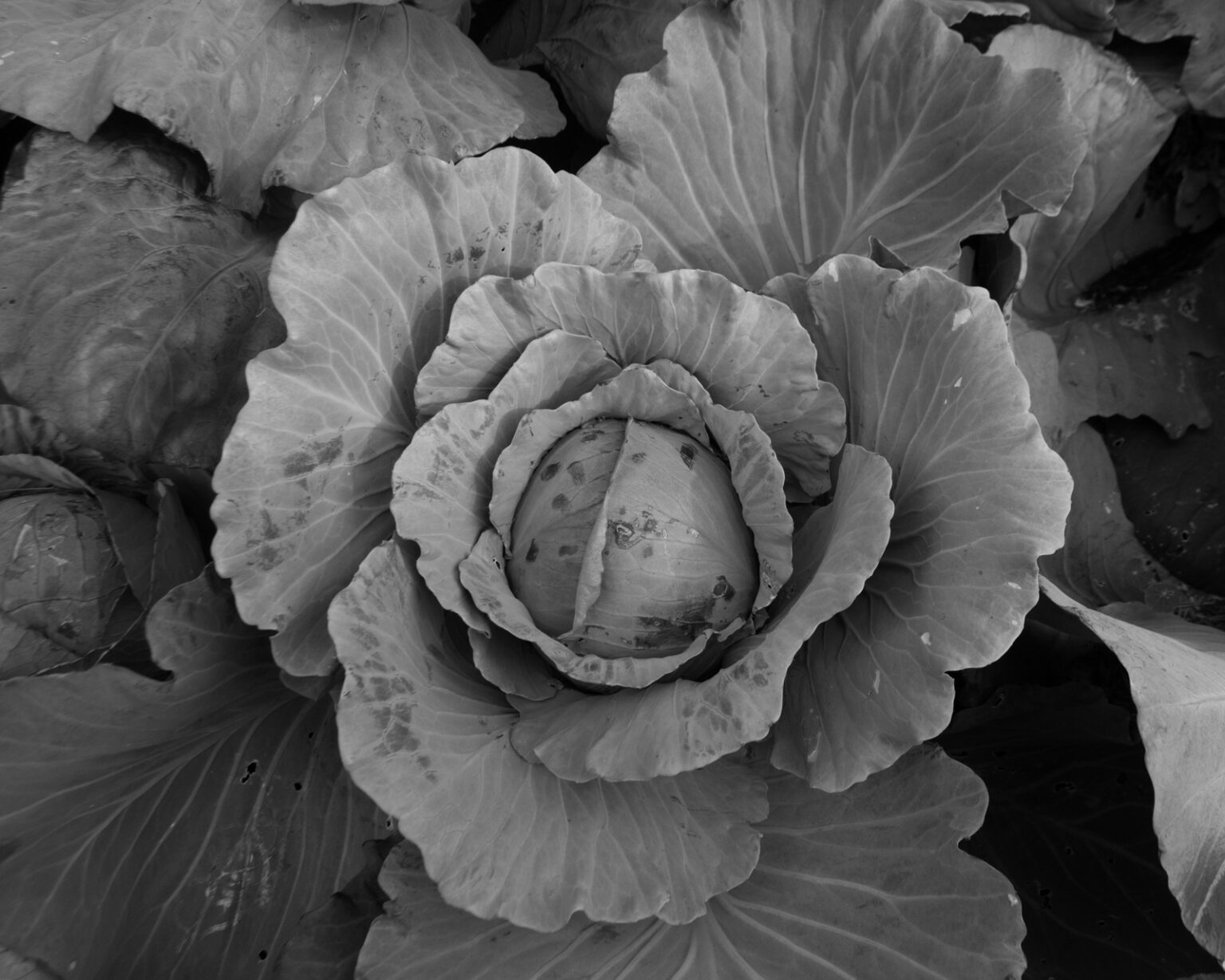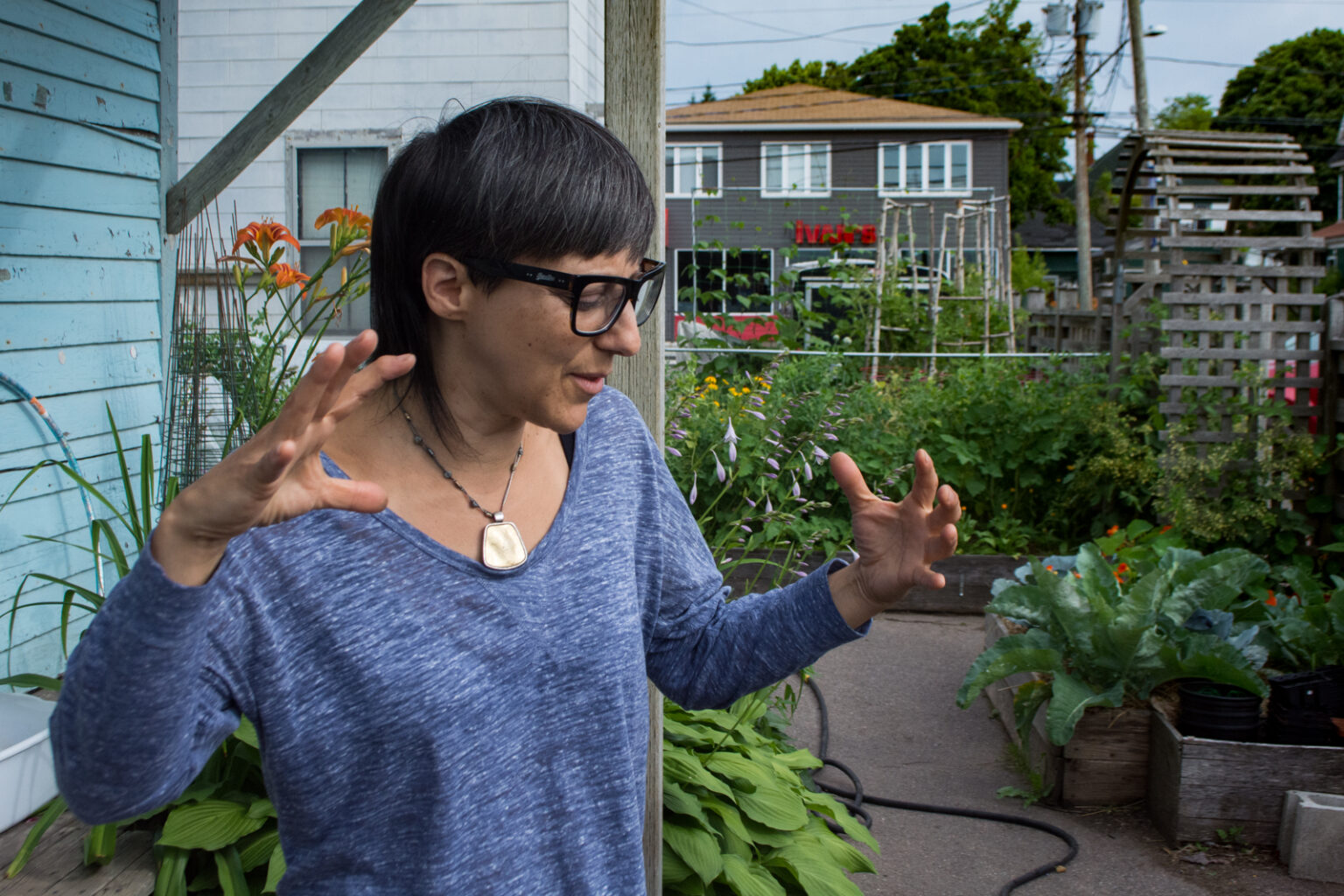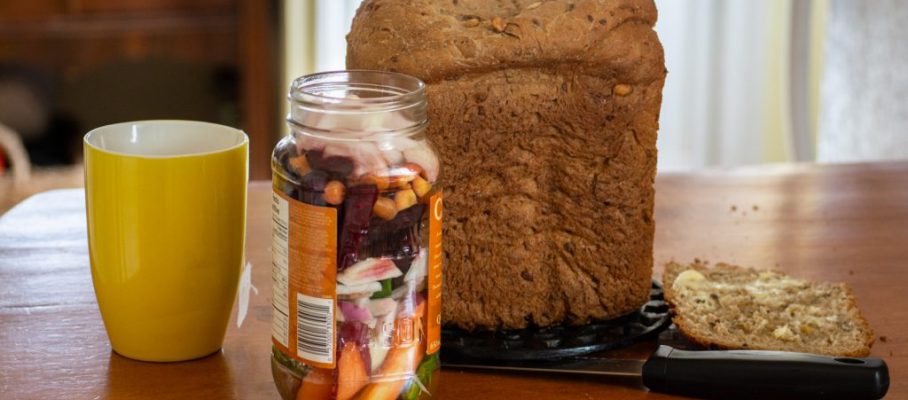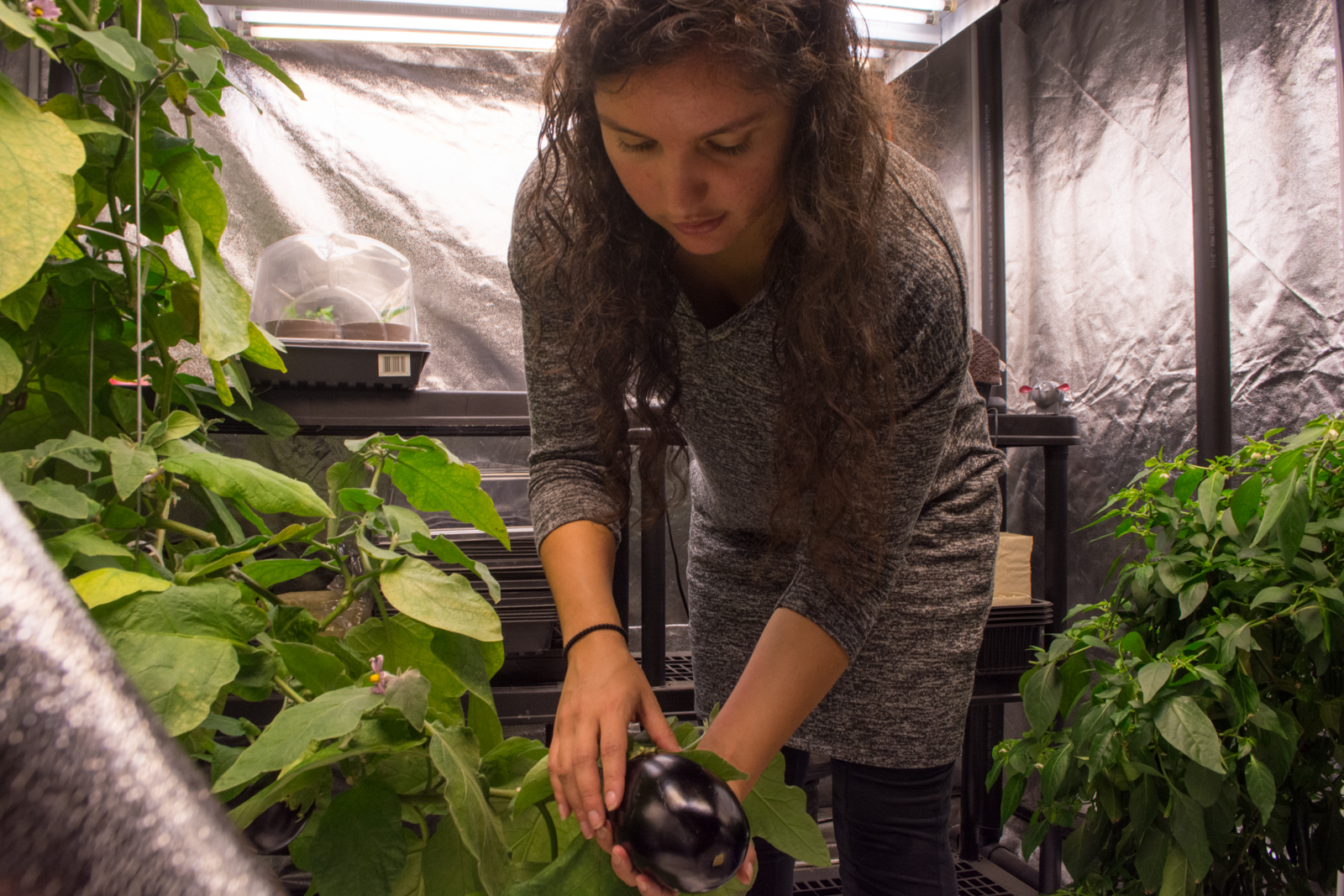Sep 28 2017
Evolution of a Gardener
I am always surprised and delighted when I see a little garden in an unlikely spot in the neighbourhood — behind a dilapidated steel shed, in a little alcove at an apartment building, or wrested from the woods at a seniors’ residence.
Kate Doyle, now in her fourth year of gardening, has a plot in the small yard of her downtown core home. These are tender beginnings, to grow a little food and to have an activity to share with her three- year-old daughter, Annette. Kate designed the efficient space-saving garden boxes and her husband, Eric, constructed them.

Young Gardener
Annette, aged three, loves tomatoes, tiny tomatoes that she helped plant. She knows that you eat them when they’re red.
She was excited about my suggestion to grow a sunflower house with her daughter or start a fairy garden complete with twig furniture. These are the kinds of things young mothers new at sharing gardening activities with their kids need to know. She and Annette went seed shopping together so they were sure to grow things that Annette would like to eat. Tomatoes — she especially likes tiny tomatoes!
During our visit in July the beans and peas were doing well and in August the zucchini and tomatoes were producing like crazy.
Kate is wowed by the produce of Aaron Shantz of Our Food SENB who shares an office with her at the United Way of GMSENB, and she takes some inspiration from him. His mega broccoli heads and tasty farm fresh eggs are enough to make her swoon.
Kate says she’s also connecting and learning on social media. “When I asked just yesterday or the day before, ‘How are your gardens, friends? What’s happening?’ I thought I could name like four people that had gardens, but there were about 30 comments from friends that I would never have expected to have their own gardens.”

Sharing Your Garden
Sharing how your garden is growing is a large part of the fun. You always have stories to tell.
The gardening bug
There is a contagious aspect of gardening. Kate’s neighbours have taken to growing vegetables, too, and now it’s connecting the neighbourhood in unusual ways. They got together and bought a truckload of soil; they help each other weed and pick stuff; and they even take in each others laundry if it threatens rain.
“We live on a street where there are so many awesome people. The other day when we were going to get that thunderstorm I realized that my blankets were on the line and I just messaged the group, hey, can one of you go take my blankets down, I’m not going to be home until five, five-thirty? They went and did it. They even folded them for me!” I think gardening fosters this kind of trust and consideration.
Gardening fosters trust in yourself, too. Kate says, “…the more I do it, the more confident I am in my techniques and my abilities.”

Garden Running Riot
In Scott Carsons garden, vegetables run riot, climbing wherever they can.

Scott and Angelina’s riot of a garden
A few blocks away, Scott Carson and Angelina Iapaolo are growing a garden in a battered asphalt driveway and minuscule backyard. There is an archway back entrance to this Driveway Called Eden with a trellis covered with a bounty of tiny tomatoes — free for anyone to sample. It’s also an invitation to come in.
Plants are growing everywhere. Beans are sending out scout tendrils onto the fire escape of the adjoining building. Squash vines are climbing up the back steps to the second floor. They’re pushing the boundaries over to the neighbour’s lot. But the neighbour doesn’t mind and was inspired in his own way to start growing flowers. The bright pots and blooms on his balcony are the perfect complement to this vegetable profusion.

Scott Carson
Scott, his coffee and his garden on a Sunday July morning.

Scott is the main gardener and quietly goes about his work. His close-set eyes focus his attention intently on the plants. Scott is a musician (pianist) and I swear he sometimes seems to be listening to the small squeaks, hums and groans of the growing green things telling him what they need and when. Sun, water and fertility — lots of fertility. Scott fertilizes with horse manure throughout the season with great results. Scott and his partner, Angelina, are rewarded for their efforts with LOTS of food. In mid-July they already had giant heads of purple cabbage — enough to start making sauerkraut. In August, it was salsa making season with a profusion of tomatoes. September yielded zucchini as big as Scott’s forearm.
Angelina is the networker and the one who gives voice to what they are doing here with their amazing garden. She is grateful that the landlord, the owner of a fast food joint next door, lets them create this jungle of food. But I clearly see that it is the landlord that should be grateful. The garden adds to the beauty and the safety of the property and the neighbourhood that otherwise would just be decaying old houses with peeling paint and sagging porches.
Scott says gardening, ”…also elevates the energy of the area it is in.”
I can imagine this garden as a set for a sci-fi movie. The plants seem innocent enough but they grow like crazy at night when no one can see them — their conspiratorial aim: overgrow everything. Make it green. Make it beautiful.

Angelina Iapaolo
Angelina is a great front person and loves to explain their gardening process.
Angelina is the singer of the duo. I envision her and Scott making music in the garden — from the garden — intuiting the voices of plants.
The will to garden
Gardening is hard work and takes commitment. So why do people do it? Beginning gardeners are usually inspired by someone else. The desire to eat better, be more self-sufficient, and also save money are motivations for sure. Angelina says of their garden, “I think its setting, its inception, its bounty have shown people that we are like them, without much, but we made this amazing thing happen on pavement, in a rental, in a shady neighbourhood. People are growing stuff all over now and feeling so great about taking care of themselves. We are no longer an oddity. Gardening to feed ourselves is a purposeful lifestyle choice.”
She also sees their vegetable growing project as a kind of template for action. Angelina plans to share her knowhow. “When I get it all down pat I want to help replicate it for others.”

Gardening with Children
Gardening with children at the Boys and Girls Club of Moncton.
Me, Elaine, the Gardener
My grandparents introduced me to gardening. I remember being five years old and planting onion sets with them in the spring. Now, I am an avid and fairly successful gardener both at home and at the Boys and Girls Club of Moncton, where I am coordinating a gardening project, completing the circle and working with children. My grandmother grew a lot of tomatoes and I remember the fruits heavy on the vines and the green tomato chow and dill pickles she would make in fall. Something that I thought was so simple and ordinary at the time now comes across as a beautiful memory and profound lesson.

Art in the Garden
We did art with the kids because gardening is aesthetic experience.
This gardening thread was picked up again years later when I was in my twenties. I started a garden when I was a student at the University of Wisconsin in the backyard of a house we were renting. We had just read Plowman’s Folly, a book about how the practice of plowing destroys the structure and micro-organisms in the soil. They encouraged disc harrowing to prepare the soil instead. We did the next best thing, or so we thought.
We tied some cinder blocks to a garden rake and scratched away at the sod. When we dug in to plant, we discovered that someone must have worked on cars back there because we unearthed old spark plugs, distributor caps, hunks of rubber, tempered glass and shards of metal. (They made cars out of steel back in those days.) Probably the soil was soaked with oil and gasoline too because nothing much grew except some beans, but that small success was enough to keep going next year and the next. With gardening, even a small reward keeps you hooked. That’s part of its magic.
The thing about gardening is that right away you have to pay attention, you have to observe and ask questions and find solutions. Why did this plant do well and not the others? You have to look for the subtleties.
The way of the garden
In my backyard garden now, the beets are doing well, probably because I added Borax to the soil. (Beets like boron and our soil here lacks it.) It was hard to germinate peas, beans and carrots this spring, probably because it was cold and wet in May and early June and I tend to plant early.
Tomatoes are doing OK but not as well as last year. I should have rotated their position to a new bed. Peppers, I have aplenty. Lots of sun!
I have zucchini but no cucumbers yet because they are too shaded, but I did rotate their position. Were there no bees to pollinate them? You see how this works?
An avid gardener likes to grow more and more every year. And they like to take on challenges, like growing melons or exotic, finicky vegetables. This year my watermelon only grew big enough for a Barbie doll picnic!
Raindrops on turnip leaves
I’m going outside now to listen to the rain hit the leaves in the turnip patch and to see if the ears of corn have plumped up. You see, it’s like this. You think about it more and more and find yourself in the garden at odd hours, taking care of it. In the fall it might be a cool starry night and you’re wondering if it’s going to frost and you don’t want the garden to be done for another year, yet. And the things that you lavish attention on and take care of, you grow to love.
The ultimate reward of course is eating. Never before has food tasted so good. My husband, Archie, and I roast up pans of fresh vegetables from the garden in olive oil and lemon juice and eat them with torn off hunks of baguette. Gardening makes life good. It makes you realize that it’s the simple things that are so very, very good. And you want to keep it all coming — next year and the next and the next.
Success not Always Wild
One Barbie-sized watermelon this year, but it tasted so good. Next year I’ll get it right.






























Oct 3 2017
Why Kids Should Learn to Garden and Do Art
Truth is, I’m worried about the kids. The world is changing. Major shifts are underway environmentally, politically, economically — in just about every way, really. Just like kids need to learn to tie their shoes and brush their teeth, I believe they need to learn how to grow their own food, because it’s part of taking care of themselves. If kids don’t eat well, they won’t be healthy, and if they aren’t healthy, they can’t do much of anything in this challenging world.
I have been teaching gardening for the past two years at the Boys and Girls Club of Moncton, and I have been supporting that learning with “garden art.”
In early spring, when the kids are released from the grey confinement of winter and we tear out old debris, turn the soil, and plant seeds, then energy and excitement abound. Delight is always the initial reaction. From one tiny seed comes a plant and then … food. If that’s not miraculous, I don’t know what is.
Once the initial euphoria wears off, everyone sees that it’s a lot of work. It can be an effort to get up the requisite gumption and everyone groans with the prospect of numerous tasks. We need to take care of growing plants — fertilize, water, weed and nurture.
But early in the game we find our gusto again. We commit and come to love the green, growing garden. Why? Because the more you nurture a living thing the more connected to it you become. True for plants, pets and people. They learn patience, reverence and respect for how long it takes to grow food. They learn to observe.
Looking for Beauty
Children find beauty everywhere in the garden. What is beautiful about doing art with children in the garden is that they see it as someplace to be, someplace they can spend time with growing things.
Furthermore, we look for beauty in the garden and have fun expressing that in art, and there the learning deepens, the mind is calmed and the soul is fed. Some see glowing light around the plants and draw that. Some talk to the plants and caress them like pets. They gently hold small bugs found in the soil or on leaves and watch them wiggle their antennae and give them names. We draw these bugs or create some out of found natural objects, paint and glue. Some of the kids dance and play. Gardening is a theatre where simple acts are an antidote for cynicism and a balm for the imagination.
Growing Food Makes You Generous
Growing your own food is the single most important act you can do to reclaim power politically and socially. With this basic activity you break your dependence on the corporate food system, using your labour and skills. Who knows what is going to happen to our food supply in the next few years? Who knows how it will be for the kids?
By growing your own food, you save money. It’s an economic buffer. And you know where your food comes from and what you’re getting. You become more connected to other people. I am compelled to generously and proudly share food with family and neighbours. And the kids are too. They always want to bring some home for their families.
Vegetable gardening is the single most important thing you can do for health. It works the body, the mind and gladdens the spirit. Homegrown veggies are more nutritious. Many people have never experienced, or have forgotten, the amazing flavour and intense vitality that comes from fresh vegetables and herbs. Feels like life bursting into your mouth. There is absolutely no other experience like it. In my mind, eating well is a form of self respect.
Even Raw Onions
The kids can’t wait to pick and eat the food. And they eat it all. Even raw onions. Even raw turnips and beets. I do show them how to cook too, but sometimes they can’t wait.
Cooking is just as important as growing food. I teach them to cook and they always love what we make. They also love the way the other children love what they make. The proof that the food is delicious is that it’s always gone at the end.
Growing your own food is a practical and loving way to connect with your kids. It’s an opportunity for fun, conversations, learning science, seeking beauty, and fostering expression through the visual arts or writing stories and poems. And with all of this comes a sense of collective accomplishment.
Gardening and Art Go Perfectly Together
I love doing art with them to help them experience the garden more deeply. We study leaf shapes and talk about photosynthesis and press the leaves into clay to make pendants. We observe the bees, butterflies, hummingbirds visiting the plants and talk about pollination.
The level of detail that children observe the garden is fascinating in itself. They love the leaves and the bees and the fruit and the bugs. They really love the bugs.
We watercolour paint coffee filters and make them into butterfly wings. We make windchimes for the garden out of recycled silverware, their tinkling tones reminding us to eat healthy meals. We make plant growth patterns by blowing paint with a straw on paper. We decorate small clay pots and plant seeds in them to take home so they can observe the whole sprouting process more closely.
We make garden lanterns out of paper cups and paper bags and battery-operated tea lights so they can observe plants at night in their own yards or gardens.
We make necklaces and bracelets out of seeds and beads just because it’s fun and everyone wants to adorn themselves in an earthy, sprightly way like fairies or elves.
In a Garden is Hope
Gardens are all about hope. And so are children. It’s marvellous to watch how much they love to go out each week to see how much the garden has grown.
In a garden — in our garden — there is growth, change and renewal, but mostly there is hope. And lots of it.
Recently I had an experience that opened my heart wide. A sweet small boy with huge brown eyes, dark lashes and a half moon smile still full of baby teeth, twirled and skipped as we made our way to the garden bed. He had recently arrived in Canada.
“I’m happy,” he said to me.
“That’s great! If you’re happy I’m happy. Why are you happy?”
“Because you are growing food for us.”
And he ran off to see how the peas were doing, plucked a pod and popped the whole edible “pois mange tout” into his mouth. So simple and satisfying.
Growing food is hope, making art is hope. Children are hope, growing so much in one season just like the plants. And with hope we are like the plant’s roots, always seeking what is fertile ground. And we are forever like the sunflowers, turning our faces toward the sun.
By Elaine Mandrona • art, children, food security • Tags: art, children, food, gardening, urban gardening